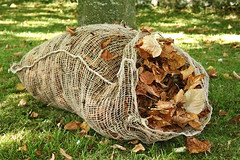Recipe for the Perfect Compost
Wondering about how to start composting, but don’t know very much? Annoyed that your compost isn’t breaking down properly? Too many leaves in your garden this Autumn that you don’t know what to do with? Let me enlighten you with a simple recipe for the perfect compost, to encourage you on your green-living way.
For this recipe, to create healthy, nutrient filled compost, you’ll need
- a food waste bin or kitchen composter
- some leaf sacks
- an outdoor compost bin
- a garden with some plants and trees.
This recipe will take a few minutes of time here and there for the next few months to complete and is suitable for a tub or two of compost.
The Carbon – Nitrogen Ratio
The ideal compost contains a combination of carbon and nitrogen, about 30: 1 Carbon: Nitrogen. This ratio is really important for successful compost. All waste products contain varying amounts these nutrients, some higher in one over the other. If an ingredient for your compost (a waste product) has more carbon than this ratio, (i.e. 50 : 1, Carbon: Nitrogen) it’s known as a “brown” ingredient. If a waste product has less carbon than this ratio, (i.e. 15 : 1) it’s known as a “green” ingredient. You need a good mixture of brown and green ingredients to make healthy compost. It helps the microorganisms present in the compost to digest the compost and break it down properly.
Here’s a table inspired by Home Composting Made Easy of some possible ingredients for your compost and their own carbon – nitrogen ratio.

Remember that the ratio you’re heading for is 30 : 1. Be careful when adding ingredients like woodchip or sawdust as these are very carbon heavy. You’ll need to compensate other ingredients if you add too much. Imagine adding 10 times as much flour to a victoria sponge cake – the cake won’t be very edible. Likewise, only adding fresh scraps of food and nitrogen heavy ingredients like manure can equally have negative effects. Imagine tripling the amount of butter in your cake – it’s just not good for you!
Leaves: One of the Tastiest Ingredients

Leaf Sacks
One of the most important staple ingredients for your compost is leaves. Most of us have been wondering what to do with the plethera of leaves flung all across our garden, so here are two suggestions for you:
- Let the leaves begin to rot and turn into mulch and add to your compost straight away
- Begin stockpiling – storing up bags of dry leaves in a holding area for later in the year
Leaves are very rich in nutrients and apparently an earthworm’s favourite food. Earthworms digest the leaves and leave an even richer solution, perfect for compost. Start bagging leaves up for later in the year, to add to your compost throughout the winter and spring. Leaves perfectly complement kitchen waste and when added to a compost bin, the pile heats up and decomposes quickly.
What Not to Add
There are of course a few ‘no-no’ ingredients, that will taint your compost. Try to avoid ivy and dandelions, as these are persistant weeds that may take root in the compost. Don’t put tomato plants in the compost either, these can carry diseases. Avoid adding cooked rice, dairy products, magazines or other glossy printed paper, meat and oils.
Getting the Temperature Right
Great compost needs heat. Unlike cakes, the ingredients in compost react together, creating the heat themselves. This provides the atmosphere that the microorganisms need to break down the contents of the compost. To get to the right temperature, you’ll firstly need a good combination of ‘green’ and ‘brown’ ingredients. Moisture is also really important – if your compost heap is dry, try adding a bit of water to the mix. You can also try adding a Compost Accelerator or Compost Activator to encourage activity and breakdown of the waste.
What else?
There are many other tips and tricks out there for great compost. I’ve heard that used coffee grounds work well as accelerators for compost, used tea too. We would love to hear from you on this – what tips and tricks do you use for great compost? Any big mistakes you’ll never make again? Anything you’ve learnt you didn’t know before?
We look forward to hearing from you…


We keep rabbits at home. We find that adding some of the soiled woodshavings and droppings from when we clean out the rabbits works well in the compost bin, but putting too much sawdust in has a very negative effect! Now I know why!
I never realised that making compost could be so technical! These are some great tips on getting it right and will certainly help me in the garden.